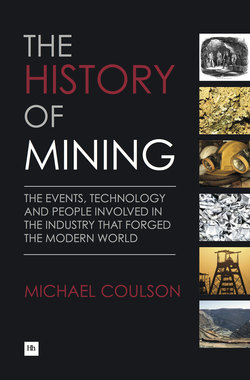Читать книгу The History of Mining - Michael Coulson - Страница 59
На сайте Литреса книга снята с продажи.
Early tensions between British and Boers
ОглавлениеIn due course the diamond discoveries led to land disputes between the two Boer republics, the Griquas and the British, which were finally settled by the annexation of the disputed areas by the British in 1870. Before that, outraged by manoeuvring by the Transvaal over concessions on the north side of the Vaal, the diggers had set up an independent republic, which lasted only until the British sent a magistrate to the Vaal River diggings to protect the rights of British diggers. But as so often happens in the mining industry, events were soon to overtake these Klipdrift disputes. Early in 1871 new discoveries were made little more than 20 miles away at the farms of Dorstfontein and Bultfontein and then at Vooruitzicht, which was renamed De Beer after the name of the farm’s owner. Finally the discovery that was to ignite South Africa’s diamond industry was made nearby at what was named New Rush. The discovery was in the form of a volcanic pipe, which eventually became known as the Big Hole, and around it grew up the town of Kimberley.
Diamonds come in two basic forms; they are either gem stones or industrial stones. Gem stones used in the making of jewellery are the most valuable, being able to be cut into a variety of shapes and then polished to a lustrous finish before being set in a jewellery piece, often made of gold. Diamonds are amongst the hardest minerals found and cutting them is a highly skilled art. The trick is to find flaws within the diamond that allow a cutter to saw or break the diamond as he shapes the stone. A large diamond may only be able to be cut into a much smaller stone but the diamond residue is valuable as it can usually, itself, be cut into smaller diamonds. A gem diamond has great value due to its rareness but in terms of usefulness, its beauty is its sole asset.
Industrial diamonds, in contrast, have great use as a cutting instrument in their own right and are used in particular in drill bits to cut through rock or as abrasives to cut, grind or polish other materials, including gem diamonds in the shaping and polishing process. Not only are they extremely hard, diamonds also do not heat up during cutting and metal can be cut extremely thin by a diamond cutter. Diamond can also be used to draw very fine wire. Industrial diamonds cannot be used to make jewellery stones as they lack the colour and clarity so important for cut and polished gems. Also, though diamonds are one of the hardest minerals known, the natural flaws and weaknesses in many stones mean that they can fracture and shatter.
For instance, the stones that lie off the coast of Namibia and South Africa are only a fraction in number of the stones from inland kimberlite pipes washed down the Orange River over many millennia. Some stones did not make the open sea but were caught in traps on the river bed and in many cases buried in the mud, many others were too flawed to survive such a journey and had been shattered into worthless shards and un-mineable dust as they bounced down the rocky river course.
